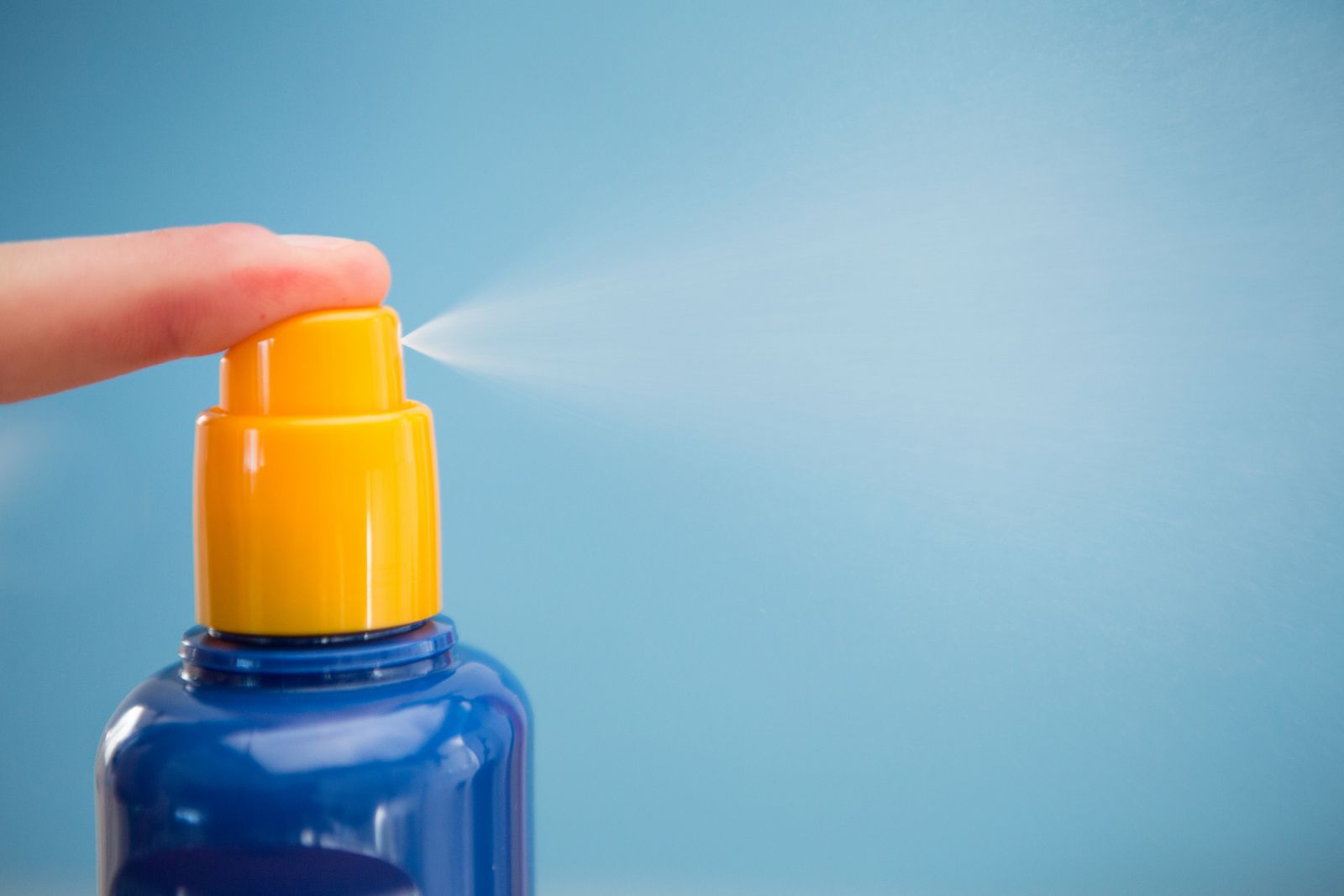Welcome to the DermacenterMD Blog
Posts for tag: sun
What could excessive sun exposure potentially do to my skin?

- Increase signs of aging
- Wrinkles
- Leathery appearance
- Pigment Changes
- Age Spots
- Loss of Elasticity
- Broken blood vessels
- Freckles
- Greatly increase your chances of getting skin cancer
- Basal Cell Carcinoma- the most common form of skin cancer found in the outer most layer of the skin
- Squamous Cell Carcinoma- the second most common form of skin cancer that can cause disfigurement
- Melanoma- the most serious form of skin cancer that is potentially fatal
Yes, you read that right. Exposing your skin to the sun without protection can cause you to look older, damage your skin and even potentially cause death. Skin cancer is a serious problem that most people overlook. Protecting your skin from the sun by taking the proper precautions, such as wearing sunscreen, can make you happier and healthier. Wearing your sunscreen can save your life!
.jpg) Hello My Friend,
Hello My Friend,
I sit down to write this blog post as I read yet another article about the potential health epidemic tied to the skin. What problem? Vitamin D is the problem. Maybe you have heard of the stir it has caused, and maybe not. According to WebMD, researchers have found low Vitamin D to be a problem in too many Americans. Scientific America reported up to three-quarters of U.S. teens and adults are deficient in Vitamin D, the so called “sunshine vitamin.”
What does this have to do with you and me? Well Vitamin D is a vitamin which uses a conversion process in the skin to make it useful for our body. The conversion process requires sunlight. So, many people have jumped on a bandwagon trying to encourage more sun exposure. The benefits are felt to be elevated Vitamin D levels and a reduction in the possible problems tied to low Vitamin D like cancer, heart disease, infection, and other health problems.
The problem is that skin cancer is also rising at epidemic proportions. In fact, over 3.5 million cases of basal cell or squamous cell carcinoma are diagnosed in the U.S. each year. Some experts estimate as many as 1 in 3 Americans will get skin cancer at some point in their life.
Therefore, we are caught in a dilemma. Should we get more sun or not? The American Academy of Dermatology has made it clear we cannot put ourselves at risk of skin cancer if possible. They provided a position statement to describe their recommendations which includes to continue protecting the skin from the sun and work to get Vitamin D from dietary supplements. Taking oral Vitamin D was felt to be the most important step in getting levels up to normal if they were low.
In short, we should be aware of this ‘hot topic’ as well as our own Vitamin D levels. In addition, we need to make sure we are taking enough daily, and still be aware of the harmful impact the sun can have on the body.
I wish you all much success, peace, and happiness.
Roger Moore, MD
When Sunscreen Safety is Called Into Question
The Skin Cancer Foundation
Source: www.skincancer.org
For years, dermatologists have told us sunscreen protects skin. Now, many people are questioning that advice after an environmental group challenged the safety of many popular brands.
"Patients are confused," said Dr. Darrell S. Rigel, a clinical professor of dermatology at New York University who is a skin cancer researcher. "I've had patients come in and ask, 'Am I harming myself by using it?' I've spent a lot of time talking to people about it."
The latest report comes from the Environmental Working Group, which claims that in an investigation of nearly 1,000 sunscreen products, four out of five offer inadequate protection from the sun or contain ingredients that may pose a health risk.
But dermatologists who reviewed the group's research say the biggest problem is that it lacks scientific rigor. In particular, they are critical of a sunscreen rating system that they say is arbitrary and without basis in any accepted scientific standard.
"What they are doing is developing their own system for evaluating things," said Dr. Warwick L. Morison, professor of dermatology at Johns Hopkins and chairman of the Skin Cancer Foundation's photobiology committee, which tests sunscreens for safety and effectiveness. "Using this scale to say a sunscreen offers good protection or bad protection is junk science."
Dr. Morison has no financial ties to sunscreen makers, and his work with the Skin Cancer Foundation is unpaid. Sonya Lunder, a senior analyst with the Environmental Working Group, said the database and rating system were based on an extensive review of the medical literature on sunscreens. Of nearly 1,000 sunscreens reviewed, the group recommends only 143 brands. Most are lesser-known brands with titanium and zinc, which are effective blockers of ultraviolet radiation. But they are less popular with consumers because they can leave a white residue.
The group is especially concerned about the safety of a compound called oxybenzone, which is used in most popular sunscreens. But the research on oxybenzone is limited.
Most recently, the Centers for Disease Control and Prevention analyzed 2,517 urine samples collected in 2003-4 from a representative sample of the population over age 6 as part of a national health and nutrition survey. The analysis, published this month in the journal Environmental Health Perspectives, found oxybenzone in 97 percent of the samples.
The study goes on to note that human exposure to oxybenzone "has not been associated with adverse health effects" and that sunscreen is an important tool to protect against sunburn and skin cancer. But the researchers said further study was needed to determine whether the chemical had any meaningful effect on the body.
"What's the meaning of it?" said Dr. Rigel, who has consulted for sunscreen makers. "Nobody's seen any problems from years of these agents being used. To call it dangerous is misleading."
A few animal studies have raised concerns that oxybenzone could disrupt endocrine functions. Several researchers say that this is a theoretical concern and that no such effect has been shown in humans.
Another study, published two years ago in Free Radical Biology and Medicine, raised troubling concerns about what happens when sunscreen is absorbed into the skin and reacts with the sun. The report suggested that under certain conditions, sunscreens with oxybenzone and other ultraviolet filters could lead to free-radical damage to the skin, a process that in theory could lead to skin cancer. The study used laboratory models of skin, so some researchers say it is not a reliable indicator of what happens in people.
But the authors noted that the damage occurred only when ultraviolet light reached sunscreen that had penetrated the skin. The solution, they say, is to keep applying sunscreen to block out the UV rays. "It may seem counterintuitive, but by reapplying sunscreen we protect ourselves from the UV light reaching any of the UV-filters that may have penetrated to the skin," said Kerry M. Hanson, the lead author of the report and a senior research scientist at the University of California, Riverside. "At this point, I don't think there's enough evidence to firmly claim that sunscreens containing oxybenzone are unsafe."
Still, Dr. Hanson added that the UV filters used in sunscreens needed testing "to give us a better understanding of how these molecules behave in the skin."
One solution, she said, may be to add antioxidants to sunscreen to counter the effect. She said she had consulted with sunscreen makers on the issue.??
The Food and Drug Administration is preparing rules that will give consumers more information on the label about the sunscreens they buy. Most doctors still recommend sunscreens with a high SPF number and a combination of avobenzone and oxybenzone, ingredients that protect the skin from two types of ultraviolet rays, UVA and UVB.
Avobenzone, also called Parsol 1789, can degrade quickly in the sun. But many top brands, including Johnson & Johnson's Neutrogena with Helioplex, Aveeno with Active Photobarrier Complex and several Coppertone brands, are formulated to prevent that. L'Oreal products containing the new ingredient Mexoryl also offer broad-spectrum protection, doctors say.
It is important to keep in mind that sunscreen is only one way to protect the skin. Not only do people typically not use enough sunscreen, but they don't take other steps to protect themselves from the harmful effects of the sun.
"People focus so much on sunscreens," Dr. Morison said. "It should be a package of protection. A hat, staying out of the sun, avoiding the hottest part of the day and covering up are all part of the whole story. It's not just the sunscreen."
 From The Skin Cancer Foundation
From The Skin Cancer Foundation
Source: www.skincancer.org
A new study appearing in the journal Nature greatly reinforces the findings of an earlier landmark genetic study linking damage from the sun’s ultraviolet rays (UVR) to melanoma, the deadliest form of skin cancer. In 2009, researchers out of Hinxton, England, used new molecular technology to examine the complete genetic material (the genome) of a melanoma taken from a patient with the disease, identifying thousands of mutations (genetic flaws) caused by damage from solar UVR. The study has been seen as the greatest evidence to date that UVR causes genetic damage that may lead to melanoma.
Now, researchers at Harvard and MIT have studied the genomes of 25 melanoma patients. They discovered a specific gene, PREX2, that was damaged and mutated in 11 of the 25 genomes. They observed, furthermore, that the amount of mutations in this gene was directly linked to chronic UV exposure; the more exposure patients had, the more mutations they had in PREX2, apparently confirming the role of sun damage in melanoma development. PREX2 mutations have occasionally been reported in colon, lung, and pancreatic cancer, and frequently reported in breast cancers; they have been found to accelerate tumor formation in human melanocytes (the pigment cells where melanomas develop).
PREX2 normally interacts with a certain tumor-suppressing protein; UV damage may cause changes in PREX2 that allow the protein to turn from a tumor suppressor into a tumor promoter, thereby leading to melanoma.
“We still can’t say we know exactly how it works,” says Levi A. Garraway, senior coauthor of the study. “But PREX2 may be a very new category of mutated cancer genes that point us to at least one and maybe more pathways worth targeting therapeutically in melanoma.”
Professor Mark Middleton, director of Cancer research UK’s Experimental Cancer Medicine Center at the University of Oxford, said that the study highlighted the important role played by sun damage in melanoma, and emphasized the need to follow simple sun safety measures such as shade, clothing, and SPF15+ sunscreen.
 Adults who use sunscreen daily can drastically reduce their risk of developing melanoma, the deadliest form of skin cancer, according to recent landmark research from Australia. Researchers found that daily application of an SPF 16 sunscreen to the head, neck, arms, and hands reduced melanoma incidence by half in study participants.
Adults who use sunscreen daily can drastically reduce their risk of developing melanoma, the deadliest form of skin cancer, according to recent landmark research from Australia. Researchers found that daily application of an SPF 16 sunscreen to the head, neck, arms, and hands reduced melanoma incidence by half in study participants.
In the Australian study, led by epidemiologist Adele Green, MD, University of Queensland, more than 1,600 white Australian adults between age 25 and 65 were studied for more than a decade. The subjects were divided into two groups, one told to continue using (or not using) sunscreen as they always had, the other given careful instruction in proper daily sunscreen application. The subjects were monitored closely through daily self-reports of sunscreen use, as well as collection and examination of all the sunscreen containers they had used. Only 11 melanomas developed in the daily sunscreen users, vs. 22 in the control group, a 50 percent reduction. In addition, invasive melanomas (tumors that penetrate beyond the skin surface) were reduced by 73 percent (3 tumors vs. 11) and average thickness by more than half a millimeter in the daily sunscreen group.
The trial's findings are the first to provide strong direct evidence for a reduction in the incidence of invasive melanoma after regular application of broad-spectrum sunscreen in adults. The scientists acknowledge that the study was relatively small and needs to be reinforced by further research, but consider their results convincing enough to recommend daily sunscreen application, along with "other standard sun protection measures like avoiding midday sun and use of protective clothing."
From: The Skin Cancer Foundation
Source: www.skincancer.org
Archive:
Tags
- dry skin (2)
- moisturizer (1)
- sensitive skin (3)
- PA (2)
- Skincare (2)
- skin cancer (29)
- cancer (6)
- facts (1)
- skin (19)
- dermatology (22)
- skin care (19)
- cosmetic (2)
- wrinkles (1)
- Botox (4)
- Dysport (3)
- sleep (1)
- look good (1)
- daily routine (1)
- healthy lifestyle (1)
- doctor (2)
- patient (1)
- sun protection (5)
- sunscreen (14)
- aging dermatology (1)
- providers (1)
- tanning (2)
- sun (6)
- UVA rays (2)
- UVB rays (2)
- melanoma (10)
- Acne (2)
- Treatment (2)
- sunscren (1)
- sun exposure (5)
- Melanoma Monday (2)
- Skin Cancer Awareness Month (1)
- education (2)
- skin cancer specialist (1)
- basal cell carcinoma (1)
- squamous cell carcinoma (1)
- ingredients (2)
- improve your smile (1)
- cosmetics (1)
- laser (1)
- fillers (2)
- sunburn (3)
- avoid the sun (1)
- hat (1)
- sun clothing (1)
- SPF (1)
- Rosacea (3)
- NP (1)
- Nurse Practitioner (1)
- mid-level provider (1)
- physician (1)
- dermatologist (6)
- cosmetic dermatology (4)
- anti-aging (2)
- youthful looks (1)
- Eczema (2)
- rash (2)
- itch (1)
- the rash that itches (1)
- reduce itch (1)
- itching (1)
- getting along with others (1)
- basal cell (2)
- squamous cell (2)
- detection (1)
- Mohs surgery (2)
- photoaging (1)
- Inspiring (1)
- word of the day (1)
- inspiration (3)
- uplifting (1)
- protection (4)
- lips (1)
- reduce wrinkles (1)
- look younger (1)
- encouragement (1)
- never give up (1)
- you can do it (1)
- medical school (1)
- dreams (1)
- brown spots (1)
- moles (2)
- liver spots (1)
- age spots (1)
- Abe Lincoln (1)
- life lessons (1)
- lip cancer (1)
- health (12)
- motivation (1)
- work (1)
- people (2)
- home life (1)
- lifestyle (1)
- ABCDEs of Melanoma (1)
- mole (1)
- skin check (2)
- skin facts (2)
- odd (1)
- fun (1)
- interesting (1)
- lung cancer (1)
- disease (1)
- Christmas (2)
- gifts (1)
- sun burn (1)
- winter skin tips (1)
- itchy skin (1)
- winter skin (1)
- myths (1)
- myth busted (1)
- skin protection (1)
- sunscreen safety (1)
- specialist (1)
- red skin (1)
- irritation (1)
- feel good (1)
- helping (1)
- help (1)
- helping others (1)
- treatment options (1)
- skin health (9)
- Vitamin D (2)
- tanning beds (1)
- skin health. dermatology (1)
- sunshine (1)
- awareness (1)
- prevention (1)
- sun damage (3)
- connections (1)
- working together (1)
- health care (1)
- biotin (1)
- medical (1)
- aging (1)
- elkhart (1)
- Roger Moore (1)
- check (1)
- skin type (1)
- skin cancer prevention (1)
- gift guide (1)
- Christmas gift guide (1)
- Dr. Roger Moore (1)
- holidays (1)
- family history (1)
